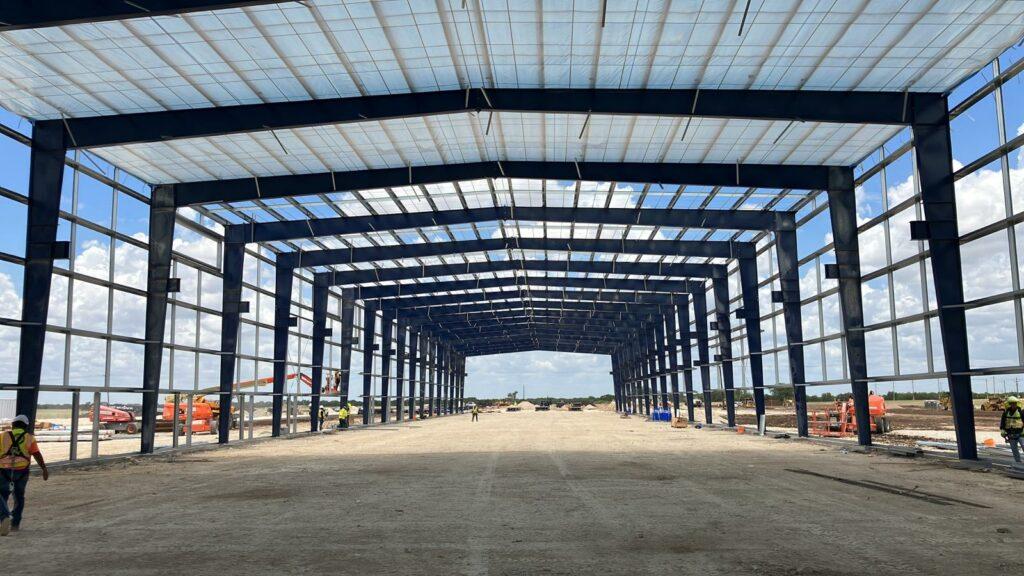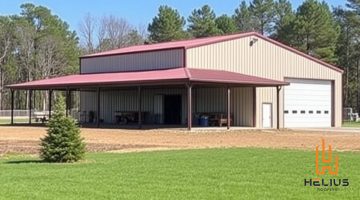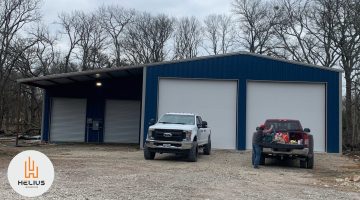By Helius Roofing & Construction, Celina, TX

Pre-engineered steel buildings have become a popular choice for construction projects ranging from residential garages to commercial warehouses. These versatile, durable, and cost-effective structures offer numerous benefits, including faster construction times, lower maintenance costs, and design flexibility. However, like any building project, pre-engineered steel buildings come with potential pitfalls that can lead to costly mistakes if not properly managed.
At Helius Roofing & Construction, we’ve seen firsthand how these common errors can affect a building project. Whether you’re erecting a steel barn, an industrial space, or a workshop in Celina, TX, understanding these pitfalls can save you time, money, and headaches. In this article, we’ll explore the three biggest mistakes to avoid when working with pre-engineered steel buildings and offer tips on how to ensure a successful project from start to finish.
Mistake #1: Underestimating the Importance of Site Preparation
One of the most common mistakes people make when using pre-engineered steel buildings is neglecting or underestimating the importance of site preparation. The foundation and site on which your building will sit are crucial for ensuring the long-term durability and stability of the structure. Skimping on proper site preparation can lead to structural issues, increased costs, and delays in the construction timeline.
Why Site Preparation Matters
Pre-engineered steel buildings are designed to be highly efficient, but they require a stable and level foundation to perform as intended. Any inconsistencies in the ground, such as slopes, dips, or soft spots, can create problems during construction and affect the overall integrity of the building. An unstable foundation can lead to shifting or settling over time, which may cause the building to become misaligned, affecting its functionality and appearance.
Common Site Preparation Mistakes to Avoid
- Failing to Conduct a Proper Site Survey
Before breaking ground, it’s essential to conduct a thorough site survey to understand the condition of the land. Factors such as soil composition, drainage, and grading need to be evaluated to determine if additional work is required to prepare the site for construction. Failing to do this can lead to costly surprises down the line, including the need for unexpected excavation, soil compaction, or drainage system installation. - Inadequate Foundation Design
The foundation is critical to the stability of your steel building, but some builders may attempt to cut corners by using a cheaper or less robust foundation design. This can be a costly mistake. The type of foundation you choose should be based on the size, purpose, and weight of the building, as well as local building codes and climate considerations. For example, a commercial warehouse will require a more substantial foundation than a small residential garage. - Ignoring Local Building Codes and Zoning Requirements
Every locality has specific building codes and zoning requirements that must be adhered to when constructing a new building. Some homeowners or business owners may neglect to obtain the proper permits or ignore setback requirements, leading to fines, delays, or even the need to dismantle the structure. Always consult with local authorities to ensure your building project complies with all regulations before beginning site preparation.
How to Avoid Site Preparation Issues
At Helius Roofing & Construction, we recommend working with a professional site surveyor and contractor to evaluate your property before starting any construction. Proper site preparation should include:
- Conducting soil tests to determine if the land is suitable for supporting the building.
- Ensuring the site is level, well-drained, and clear of debris.
- Designing a foundation that meets the specific needs of your steel building and complies with local codes.
By investing in proper site preparation from the start, you can avoid costly mistakes and set the stage for a successful construction project.
Mistake #2: Choosing the Wrong Size or Design for Your Needs
Another common mistake when using pre-engineered steel buildings is selecting the wrong size or design for the intended purpose. While pre-engineered steel buildings are highly customizable, choosing a design that doesn’t match your needs can lead to issues with space, functionality, and even compliance with building codes.
Why Size and Design Matter
Pre-engineered steel buildings are typically designed for specific uses, whether it’s a storage facility, a commercial space, or a barn. Choosing a design that doesn’t align with your long-term plans can limit the usefulness of the building, create overcrowded or underutilized spaces, and increase the risk of needing future modifications or expansions. It’s important to think beyond your immediate needs and consider how the building will be used in the future.
Common Design and Sizing Mistakes to Avoid
- Underestimating Future Space Needs
One of the biggest mistakes is building a structure that is too small for its intended use. For example, a small warehouse might be sufficient for your current operations, but if your business grows, you may quickly find that the space is inadequate. Expanding a steel building after construction can be difficult and expensive, so it’s important to plan for future growth and needs. - Overbuilding Without a Clear Plan
On the flip side, building a structure that is too large for your current needs can lead to wasted space and increased construction costs. While it’s always a good idea to plan for future growth, building an oversized structure without a clear plan for how the space will be used can lead to inefficiencies and higher maintenance costs. - Ignoring Functional Layout Considerations
The internal layout of your steel building is just as important as the exterior dimensions. For example, if you’re building a warehouse or manufacturing facility, consider the flow of goods and personnel through the space. Failing to design a layout that promotes efficiency can lead to bottlenecks and reduced productivity. In residential or recreational steel buildings, think about how rooms, partitions, and storage areas will be organized to meet your needs.
How to Avoid Size and Design Issues
To avoid choosing the wrong size or design, consider the following tips:
- Assess Your Long-Term Needs: Think about how you plan to use the building now and in the future. Will you need extra storage? Will you expand your business? Planning for future growth can save you money and time in the long run.
- Consult with a Design Expert: At Helius Roofing & Construction, we work closely with our clients to ensure that the design of their steel building matches their specific needs. From floor plans to customizations, we help you create a building that works for you.
- Plan for Versatility: If you’re unsure about your future needs, consider a versatile design that allows for flexibility in use. For example, you can include open spaces that can later be partitioned as needed or design the structure so that it can be easily expanded.
Mistake #3: Failing to Plan for Long-Term Maintenance and Durability
Pre-engineered steel buildings are known for their durability and low maintenance, but that doesn’t mean they are entirely maintenance-free. One of the most common mistakes is assuming that a steel building will never require upkeep, which can lead to long-term issues and costly repairs.
Why Maintenance Matters
While steel buildings are resistant to many of the problems associated with traditional construction materials (such as rot, termites, and warping), they still require regular maintenance to ensure they remain in optimal condition. Neglecting basic upkeep can result in corrosion, leaks, and other structural issues that compromise the integrity of the building over time.
Common Maintenance Mistakes to Avoid
- Neglecting Regular Inspections
Just because steel buildings are durable doesn’t mean they don’t need to be inspected periodically. Over time, exposure to the elements, such as rain, snow, and wind, can cause wear and tear on the structure. Rust and corrosion can develop, especially in areas with high humidity or salt exposure. Failing to inspect the building regularly can allow these issues to go unnoticed and worsen over time. - Inadequate Roofing Maintenance
The roof is one of the most critical components of any building, and steel buildings are no exception. Leaks, clogged gutters, or loose fasteners can all lead to serious damage if left unchecked. Regular roof inspections and maintenance are essential to ensure that your building remains weatherproof and structurally sound. - Failing to Address Small Repairs Promptly
Small issues like minor leaks, rust spots, or loose components may seem insignificant, but if left unaddressed, they can escalate into larger, more expensive problems. It’s important to deal with these minor repairs as soon as they arise to prevent them from turning into major structural issues.
How to Ensure Long-Term Durability
To maximize the lifespan of your pre-engineered steel building, follow these maintenance tips:
- Perform Regular Inspections: Schedule annual or semi-annual inspections to check for signs of wear and tear, such as rust, leaks, or loose fasteners. Address any issues as soon as they are detected to prevent further damage.
- Keep the Building Clean: Dirt, debris, and moisture can accumulate on steel surfaces and contribute to corrosion. Regularly cleaning the exterior and roof of your building will help protect it from the elements.
- Invest in Quality Materials: At Helius Roofing & Construction, we use only high-quality materials in our steel building projects, including rust-resistant coatings and durable fasteners. Investing in quality materials from the start can reduce the need for repairs later on.
Conclusion
Pre-engineered steel buildings offer a wide range of benefits, including durability, cost-effectiveness, and versatility. However, avoiding common mistakes is essential to ensuring the success of your project. By focusing on proper site preparation, choosing the right size and design, and planning for long-term maintenance, you can enjoy the full advantages of a pre-engineered steel building for years to come.











